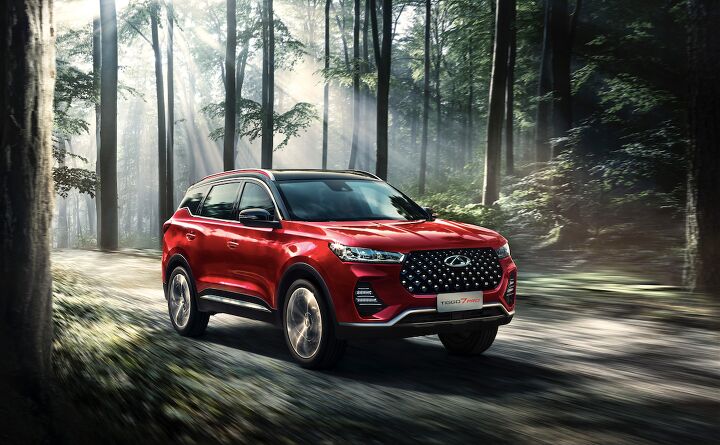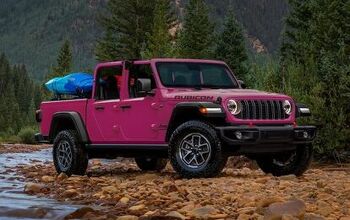Report: China’s Chery Considers U.S. Market Yet Again

Chinese state-owned automaker Chery is reportedly still looking to the United States as a possible point of expansion. But this isn’t the first time the brand has said so.
Chery had plans to break into our market back in 2005 and supposedly had things lined up to import a limited supply of its Exeed crossover in 2020 before the world went haywire. Things have been left intentionally vague this time around, with the company only saying that it would like to move product here eventually.
"[The U.S. market] is very important for us. We already have a roadmap of how to enter the U.S., but frankly speaking I can't say much more about our strategy," Brian Wu, executive vice president of Chery Mexico, told MotorTrend in a recent interview.
"I don't want to repeat the same story," Wu added. "Today is not like before. Not like it was 20 years ago."
From MotorTrend:
Wu said it's too early for Chery to talk about its new plan for the U.S. market, but added that the company is putting together a product portfolio and determining which brands could enter. "Is it Chery first, or Exeed first? Frankly speaking, we haven't decided. But we have a rough road map of the products we want to have," he said.
Chery's global brands include Chery, Exeed, Omoda, and Jetour, the latter two destined for international markets. Exeed is a luxury brand that intends to compete with Audi, BMW, and Mercedes-Benz. All brands have electric, plug-in hybrid, and internal combustion powertrains, and have expanded into markets outside of China.
While he declined to say what products are expected on U.S. soil, Wu said there would be a mix of EVs and PHEVs. "Mainly [our focus] is with new energy vehicles, but maybe some models will be ICE," he added.
While quality and safety standards are much higher in the U.S., Wu said Chery's products are on par with customer's expectations. "I do believe that these models [we have in Mexico], we can put them in the U.S. market. No quality issues, or anything. But whether a customer likes it or not, it's a different case," he noted.
I’ve been writing about the automotive industry for years and, before that, I was doing research on behalf of automakers. Chinese brands have been saying they’ll be coming to America since the mid-2000s. Back then, the companies were relegated to trade show basements — situated next to amateur design contests intended for children and collegiate conceptual engineering projects.
As insulting as it was to put the Chinese brands downstairs while established automakers enjoyed the limelight, there was a noticeable disparity between vehicles. Early Chinese models were derivative to a point that warranted harsh criticism. Even when they finally did move up to the main stage, we found improved products that were still poorly suited to American tastes. They were sized all wrong, often underpowered, and featured things like fake exhaust tips.
But the world has continued to change. Strict emissions regulations in Europe and intercontinental partnerships with Western brands have allowed Chinese-made vehicles to break into the market. We’ve even started seeing them in the United States wearing American badges. Both the Lincoln Nautilus and Buick Envision are now assembled in China. Meanwhile, just about every vehicle on the planet is at least partially reliant on a supply chain that swings through Central Asia.
Chery has only been in the Mexican market since 2022. But it’s making noticeable progress with its new “Chirey” brand and has already started outselling some of the more established nameplates. Vehicles are competitively priced and frequently feature all the latest trends and technologies (e.g. touch controls), especially where the interior is concerned. Some of those inclusions still seem to be lifted from other models. Granted, the cars are still a little rough around the edges. But Chery has continued making headway in terms of overall refinement, clearly hoping to present itself as a company focused on entry-level luxury.
However, its emblem still looks like something lifted directly off an Infiniti model.
If things continue going well for the brand, the plan is to break ground on a sizable vehicle plant in Mexico by 2024. Wu said the factory will likely focus on plug-in hybrids and all-electric vehicles. While we’ve no clue whether those models will ever make their way onto our roads, simply having a production facility in North America sets Chery up to dodge some of the regulatory hurdles associated with the revised, indefinite, EV incentive scheme and places it in a much better position in regard to USMCA regulations.
[Image: Chery]
Become a TTAC insider. Get the latest news, features, TTAC takes, and everything else that gets to the truth about cars first by subscribing to our newsletter.

A staunch consumer advocate tracking industry trends and regulation. Before joining TTAC, Matt spent a decade working for marketing and research firms based in NYC. Clients included several of the world’s largest automakers, global tire brands, and aftermarket part suppliers. Dissatisfied with the corporate world and resentful of having to wear suits everyday, he pivoted to writing about cars. Since then, that man has become an ardent supporter of the right-to-repair movement, been interviewed on the auto industry by national radio broadcasts, driven more rental cars than anyone ever should, participated in amateur rallying events, and received the requisite minimum training as sanctioned by the SCCA. Handy with a wrench, Matt grew up surrounded by Detroit auto workers and managed to get a pizza delivery job before he was legally eligible. He later found himself driving box trucks through Manhattan, guaranteeing future sympathy for actual truckers. He continues to conduct research pertaining to the automotive sector as an independent contractor and has since moved back to his native Michigan, closer to where the cars are born. A contrarian, Matt claims to prefer understeer — stating that front and all-wheel drive vehicles cater best to his driving style.
More by Matt Posky
Latest Car Reviews
Read moreLatest Product Reviews
Read moreRecent Comments
- ChristianWimmer One of my clients is a company that is actually producing eFuels in Leipzig. Yes, they require a lot of energy to produce but this would not be an issue if Germany had nuclear energy or used the excess energy from wind and solar to produce these fuels. In such a scenario the energy losses wouldn’t really matter.Also, I am told that nations like Spain or the North African nations like Morocco or Tunisia could be ideal places to produce eFuels/Hydrogen due to their abundance of solar power. Again, the energy loses here would not matter since the energy used to produce these fuels is essentially “free”. If this path were pursued, Morocco and Tunisia could become wealthy nations and exporters of eFuels and Hydrogen. Countries with an abundance of solar or wind or hydro energy could be producing eFuels for their domestic consumption and export.Another argument which to me is irrelevant these days ist the poor thermal efficiency of ICE engines (25-35% gasoline, 40-45% diesel). One long trips with cruise control set to 130 km/h and even the occasional venture into the 180-200 km/h zone, my fully loaded (with my gear) A250 (2.0 4-cylinder 224-hp Turbo) can achieve an impressive gas mileage of 6 L / 100 km. That’s phenomenal - I am looking at six 1 liter bottles of water right now and that’s all my car needs to travel 100 km… amazing.So, I am a supporter of eFuels. I love internal combustion engines and if we want to use them in a climate neural way, then eFuels are a must. Also, to me every ICE car is way more sustainable and longer-lasting an an EV. Mazda, Toyota etc. are making the right move IMO.
- Blueice Once you infuse governmental unit regulation & [marketing] and taxpayerfunding, one knows quite well, dat the product or service isdestine to fail; which includes battery vehicles. Just axe yourself how revolutionary have your home batterydevices become ??? I am still waiting. after three decades, for a battery shaver whichonly requires charging two or three times per year.I am glad that I do not have a plug in Frau.
- Tassos Such a heavy breadvan on stilts, with so much HP, AND with ONLY 100 KWH Battery, I doubt if you will ever see 250 miles, let alone 300, under the best of conditions. In the winter, count on 150 miles range.And NO, it looks TERRIBLE. The only SUV that looks great is the RANGE ROVER.
- Tassos They sure are doing the right thing in the SHORT and MEDIUM term.As for the long term, in the long run, YOU'LL ALL BE DEAD, so WHO CARES.
- Tassos I wrote recommending a 20 year old CAMRY, beat up too. So the teen will not be too upset if it gets a few more dings.Somehow I cannot find my post, though.


































Comments
Join the conversation
You've got a point. Everything has gotten grotesquely overpriced and people aren't making more money than they used to. Due to heavy handed regulations and old-fashioned greed cars seem to be priced particularly unwisely of late. The status quo is not sustainable.
Whatever company can deliver a competent product at a compelling price is going to win big, even if said product stems from China. This scheme seems to have worked for all of America's largest retailers.
@mattposky - "Volvo and Lotus". Huh? The majority of Volvos are made in Europe. Yeah Ford had a chance to have a rival to Audi/Mercedes but the MBA bean counting dipsticks sold it to Geely. That's capitalism I guess.
My take: ANY carmaker that builds, markets, and sells cars in China is a CHINESE car maker. That means Tesla, BMW, Mercedes, Ford, GM, VM/Audi/Porsche are CHINESE automakers. VW/Audi/Porsche sees China as its largest market. This is billions/millions of infrastructure investment, taxes, and employment that supports China.
Until just ONE major automaker -- I REPEAT JUST ONE (1) -- leaves China, ripping on Volvo (who still design and build cars in Sweden and Europe) is weak-sauce virtue signaling.